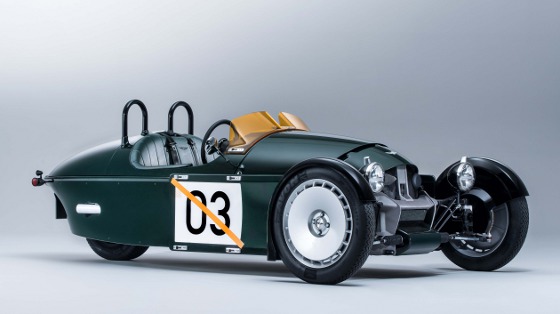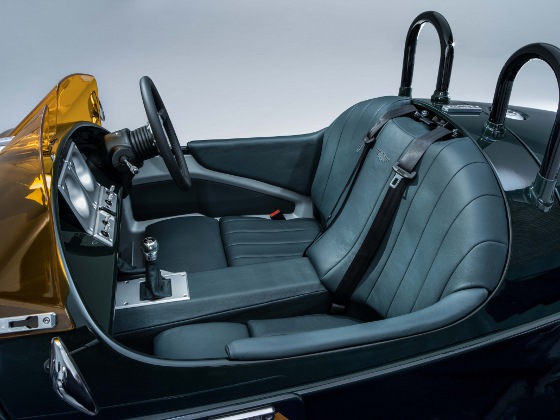 |
| April 05, 2022 | Volume 18 Issue 13 |
Designfax weekly eMagazine
Archives
Partners
Manufacturing Center
Product Spotlight
Modern Applications News
Metalworking Ideas For
Today's Job Shops
Tooling and Production
Strategies for large
metalworking plants
Run about in retro style: All-new Morgan Super 3

If classic cars with a modern twist get your motor running, then specialty British automaker Morgan Motor Co. has a little something for you. It's a two-seat three-wheeler called the Super 3 that features a clean-sheet jet-age design, a 116-hp inline three-cylinder 1.5-L Ford gasoline engine, and loads of opportunities for fun driving while you feel the road. Left-hand drive available (note red Super 3 in this article), and street-legal in the U.S. (check your state laws, may have to be registered as a motorcycle).

The engine is coupled to a five-speed Mazda gearbox, the same as in the Mazda MX-5 (Miata) and used in the outgoing Morgan 3 Wheeler. Top speed is 130 mph. Anticipated 0-to-60 acceleration time is a sprightly 7 sec.
Morgan built its first three-wheeler, the company's first production design, in 1909 called the Runabout, which boasted a two-cylinder Peugeot motorcycle engine and an independent front suspension (unusual at the time). Since then, the company has produced several upgraded versions, with most, including the outgoing 3 Wheeler design, powered by V-twin engines.
The outgoing model called the 3 Wheeler, which was launched in 2011, was created in the style of the 1920s V-twin-engined three-wheelers. The new Super 3 is something entirely different, with Morgan's designers and engineers drawing their influences this time around from the mid to late century.
Super 3 is Morgan's first clean-sheet design since the launch of the Aero 8 in 2000 and the company's biggest visual departure since the 1960s. This is noticeable in the cast aluminum structures that provide the face of the vehicle, brace the engine, and control the corner packages, while also directing air into the side-mounted cooling packs. Two rectangular diffuser plates (referred to as "sideblades") manage cooling requirements while also presenting a platform for panniers, luggage racks, and liveries.



According to the company, the exact positioning of the engine -- now car-derived and mounted in-board -- within the Super 3 is of crucial importance. Chosen in part due to its compact nature, the inline three-cylinder block sits precisely behind the front axle line, delivering optimum weight distribution and desirable proportion. The latter is a key principle for Morgan's designers, who determined it was vital that the body of the car "was visually towed by its front wheels rather than sat on top of them." Super 3 has a mechanically intricate front end and exhibits linear geometry, which is intentionally contrasted against the aerodynamic rear.
Morgan enthusiasts with recognize the Super 3's face, which includes two familiar headlights and a horseshoe front grille. Mounted on the headlight pods are two small, machined aluminum turrets. These turrets house the indicators and position lights, satisfying wide field-of-vision requirements and resulting in the headlights themselves sitting lower and delivering a low-slung aesthetic.
The engine resides beneath the nose cone, which is positioned to deliver both optimal weight distribution and desirable proportion. This visual mass sits directly behind the center line of the front wheels and is a principle proportion of Super 3. Beneath the cowl, the engine is visible through a mesh with its moving mechanical components clear to see.
Bracing the engine are structural aluminum castings finished in silver or black. These castings support the engine and corner packages while also ducting air into the cooling packs. The mechanical requirements of these castings have delivered the character of Super 3's face and have become a crucial design element.




Underpinning the Morgan Super 3 is a bonded aluminum Superformed monocoque platform (Superforming involves heating aluminum to a superplastic state before vacuum forming). For the first time in Morgan history, the platform is a true monocoque, with stressed exterior A-surfaces (as opposed to a unibody design found on most modern production cars, with bolt-on non-structural panels). Not only does this make for a lighter and more rigid chassis, but it also provides packaging benefits and gives more interior occupant space with no intrusion.
All of the elements of Super 3's wishbones, pull-rod suspension, and headlight structure have been shaped to assist airflow to the radiators behind them, and the mechanical complexity is reminiscent of that of early-century three-wheeled Morgans. The headlight stalks themselves are structural, acting as an additional brace between the upper and lower wishbone pick-up points, while continuing to reflect the vehicle's trihedral theme.
As well as providing an aerodynamic advantage, the pull-rod suspension brings dynamic benefits by reducing unsprung weight. In parallel with the shape of the front casting, it facilitates a free flow of air toward the side-mounted radiator packs. Visually, the setup reduces clutter and is yet another example of form and function being one and the same.
The engine mount strategy is unique to Super 3. Specifically, the Hartland Strut (named after the Morgan engineer that designed it) is the foremost mount and integral to the face of the car, while managing the torque reaction of the engine.



The front wheels' positive offset allows for the longest possible suspension wishbones, with the brakes mounted far out. This maximizes ride quality, handling, and stability. The inside face of the wheel arches is closed off, which works aerodynamically both to reduce wind noise and to help the flow of cooling air to the radiators behind them.
To keep Super 3 looking proportionally correct, an all-new 20-in. tire has been developed with Avon. The tire is based on the look of a heritage motorcycle tire with ballooned sidewalls, but it has been engineered specifically for Morgan and is closer to a car tire in its design. The rear tire on a three-wheeler plays a crucial role in the handling and dynamic capabilities. The company has undergone a rigorous testing program to determine the exact tire choice for the rear of Super 3.
Extensive development has also taken place to tune the feel of the controls. For example, the clutch is deliberately well weighted with a short travel to reflect the short throw of the gearbox. Particular attention has been paid to the pedal spacing also, allowing easy heal-and-toe gear changes and retaining a playful feel.
One challenge faced during the creation of the Super 3 was the desire to maintain a small footprint while also improving on the turning circle of the outgoing model. Sculpted castings carefully flank the engine, with rectangular radiators sitting outboard of these castings, and this limited the space available for the front wheels.
To overcome this challenge, the radiators have been encapsulated behind extremely thin and flat panels. On a jet aircraft, these panels would be referred to as "diffuser plates." On the Super 3, these diffuser plates are referred to as the "sideblades." The sideblades efficiently manage inbound and exhaustive airflow through the radiators. The sideblades also allow numerous luggage mounting options thanks to some uniquely designed universal fixtures, also referred to as "accessory rails."




In the rear, an exposed rib forms a beltline around the vertical midpoint of the vehicle. This feature is a nod to traditional seam-joining techniques deployed on mid-century aircraft fuselages, and it is often apparent in "belly tank" racers and early jets. Beneath it lies a unique cut-off tailpipe design, which meets regulations due to its positioning inbound of this beltline.
The rear casting integrates a hinge for the rear trunk (boot) lid and optional luggage rack, and it allows this accessory to be lifted independently or in unison with the boot. Underneath the rear clamshell lid is an enclosure sculpted to provide maximum luggage capacity.
Rated at an approved ingress protection level of IP64, any part of the interior is completely dust-tight and protected against water splashing from any direction, even down to the integrated USB sockets.


The minimalist dashboard features Morgan's traditional center-mounted dials, but for the first time in a Morgan they are fully digital. Their surrounds, which are available in both anodized black or silver finishes, are formed from metal. The engine start/stop button, inspired by the "missile release" button on military aircraft, is carried over from the outgoing model.
A choice of seat materials includes vinyl, water-resistant leather, saddle leather with enhanced durability, and a technical fabric that combines a high level of water resistance, UV resistance, and ease of maintenance. Also available for the first time is a footwell heater.
A universal fixture (the same as the ones mounted to the vehicle sideblades) is mounted under the dashboard and allows for a cup holder or Quad Lock phone mount to be fitted. Bungee cords can be fitted to the chassis impressions in the outer cockpit to provide a quick storage solution for coats, maps, and small bags, while a discreet lockable underseat compartment allows more valuable items to be stored.
Like every Morgan, Super 3 will be built in Malvern, Worcestershire, at the company's Pickersleigh Road factory. Skilled craftsmen and women have been handcrafting cars in these red brick buildings since 1914, just five years after HFS Morgan invented the first Morgan, the Runabout.
Morgan has not released official prices for the United States, but the Super 3 will probably start at just under $70,000 here. Morgan cars are handmade, so expect a fairly long wait.

Learn more at morgan-motor.com/super-3/.
Source: Morgan Motor Company
Published April 2022
Rate this article
View our terms of use and privacy policy
